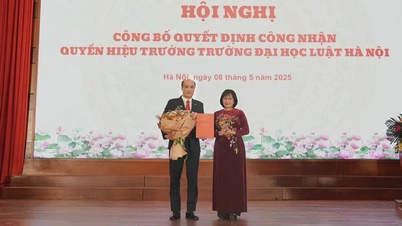While the state budget accounts for the majority of revenue for many universities around the world, in Vietnam, tuition fees play the most important role for schools.
In 2022, information about 5 universities with revenue of more than 1 trillion VND was widely shared. Of these, two are public schools, including Hanoi University of Science and Technology and Ho Chi Minh City University of Economics. The remaining three are private schools, including FPT University, Van Lang University and Ho Chi Minh City University of Technology.
According to the annual report of Hanoi University of Science and Technology in 2021, the total revenue of the school is nearly 1,426 billion VND, of which the revenue from career activities accounts for the most with more than 974.8 billion. In addition, the school receives state budget support for policies and scientific research, budget for SAHEP investment (ODA), and revenue from scientific research topics.
In terms of revenue from career activities alone, university training tuition fees account for the majority, at more than VND775.8 billion (about 79.6% of revenue from career activities and about 54.4% of total revenue). The remainder comes from the exploitation of facilities and services, tuition fees, fees and other training services.
At Ho Chi Minh City University of Economics, tuition fees account for 73.6% of total revenue in 2021. 22.5% comes from consulting, research, technology transfer, and training activities; 3.9% from other activities such as developing high-quality training programs, enhancing international cooperation, and exchanging students and lecturers. The school did not mention the state budget.
As of August 2022, 141 out of 232 schools nationwide are eligible for autonomy under the provisions of the Law on Higher Education. Depending on the level of autonomy, schools will have their budget investment partially or completely cut, causing tuition fees to account for 50-90% of total revenue.
For example, at Can Tho University, the school's total revenue last year reached nearly VND1,090 billion, of which tuition and fees accounted for nearly 50%. The state budget for the school decreased by nearly 40% compared to 2021. Ho Chi Minh City University of Industry and Trade no longer receives investment from the budget, making tuition fees a decisive factor in its survival.
Reporting at a conference on university autonomy in April, a World Bank team of experts presented data on household contributions to higher education after surveying a number of schools.
The results show that in 2017, the state budget accounted for 24% of the total revenue of the surveyed public schools; the contribution of learners (tuition) was 57%. But by 2021, tuition fees accounted for 77%, the budget source was only 9%.
It can be seen that the revenue of public schools is increasingly dependent on tuition fees in the context of low budget spending on higher education. This reality is in contrast to countries with developed higher education.
According to experts, the three main sources of university revenue in both Vietnam and the world include: state budget, tuition fees and other sources of revenue (from technology transfer, service activities, donations, public-private partnerships, etc.). In many countries, state budget accounts for the majority of revenue, not tuition fees.
According to the National Center for Education Statistics , in the 2019-2020 school year, only 20% of the revenue of US public schools came from tuition and fees collected from students, while government and local government subsidies contributed 43%. The rest came from corporate sponsorship, investment, or other sources of revenue such as gifts, revenue from educational activities, hospitals, etc.
In New Zealand, 42% of university income comes from the government, through tuition subsidies, 28% from tuition fees and 30% from scientific research, commercialization and other sources of revenue, according to statistics from Universities New Zealand - the organization representing universities in this country.
In Australia, nearly 35% of university revenue in 2020 was funded by the government, according to the Department of Education, Skills and Employment.
In terms of budget spending on higher education alone, Vietnam is in the lowest spending group.
According to the Ministry of Finance, in 2020, the budget for higher education in Vietnam was less than VND17,000 billion, accounting for 0.27% of GDP. However, the actual expenditure was only about 0.18% of GDP, according to Deputy Minister of Education and Training Hoang Minh Son at the end of last year.
Compared to 38 countries in the Organization for Economic Cooperation and Development (OECD), this rate of Vietnam is the lowest. The average percentage of GDP of OECD countries spent on higher education is 0.935%.

Students enrolling at Ho Chi Minh City University of Technology in September 2022. Photo: Thanh Tung
Associate Professor Dr. Tran Xuan Nhi, Permanent Vice President of the Association of Vietnamese Universities and Colleges, former Deputy Minister of Education and Training, acknowledged that state budget investment in higher education is too little.
"Schools that want to survive have to charge higher tuition fees even though they know it conflicts with people's living standards," said Mr. Nhi.
According to Mr. Nhi, this causes inequality in education, making it difficult for low-income people to access higher education, thereby affecting quality, making it difficult for the economy to develop.
The World Bank's expert team also said that over-reliance on tuition fees raises alarm bells about the unsustainability of higher education financing, increasing the risk of inequality in access to higher education.
The group recommends that Vietnam avoid equating financial autonomy with financial "self-reliance" or, in the narrow sense, without support from the state budget.
"No country with a developed higher education system has gradually withdrawn or completely reduced regular funding for higher education institutions, especially research-oriented universities, like Vietnam," the research team shared, arguing that Vietnam needs to increase spending on higher education from 0.23% to at least 0.8-1% of GDP before 2030.
Regarding the idea that universities need to diversify their sources of income, Mr. Nhi said it was very difficult. The two main activities of universities are training and research. Scientific research is difficult to promote without investment capital. Not to mention, from research to application in production, creating very long-term profits.
"If university autonomy is still equated with complete financial autonomy, schools will still have to rely heavily on tuition fees to survive," said Mr. Nhi.
Source link


![[Photo] General Secretary To Lam begins official visit to Russia and attends the 80th Anniversary of Victory over Fascism](https://vphoto.vietnam.vn/thumb/1200x675/vietnam/resource/IMAGE/2025/5/8/5d2566d7f67d4a1e9b88bc677831ec9d)
![[Photo] President Luong Cuong presents the decision to appoint Deputy Head of the Office of the President](https://vphoto.vietnam.vn/thumb/1200x675/vietnam/resource/IMAGE/2025/5/8/501f8ee192f3476ab9f7579c57b423ad)
![[Photo] National Assembly Chairman Tran Thanh Man chairs the meeting of the Subcommittee on Documents of the First National Assembly Party Congress](https://vphoto.vietnam.vn/thumb/1200x675/vietnam/resource/IMAGE/2025/5/8/72b19a73d94a4affab411fd8c87f4f8d)

![[Photo] Prime Minister Pham Minh Chinh meets with the Policy Advisory Council on Private Economic Development](https://vphoto.vietnam.vn/thumb/1200x675/vietnam/resource/IMAGE/2025/5/8/387da60b85cc489ab2aed8442fc3b14a)
![[Photo] General Secretary concludes visit to Azerbaijan, departs for visit to Russian Federation](https://vphoto.vietnam.vn/thumb/1200x675/vietnam/resource/IMAGE/2025/5/8/7a135ad280314b66917ad278ce0e26fa)
























































![[Photo] Prime Minister Pham Minh Chinh talks on the phone with Singaporean Prime Minister Lawrence Wong](https://vphoto.vietnam.vn/thumb/402x226/vietnam/resource/IMAGE/2025/5/8/e2eab082d9bc4fc4a360b28fa0ab94de)
































Comment (0)